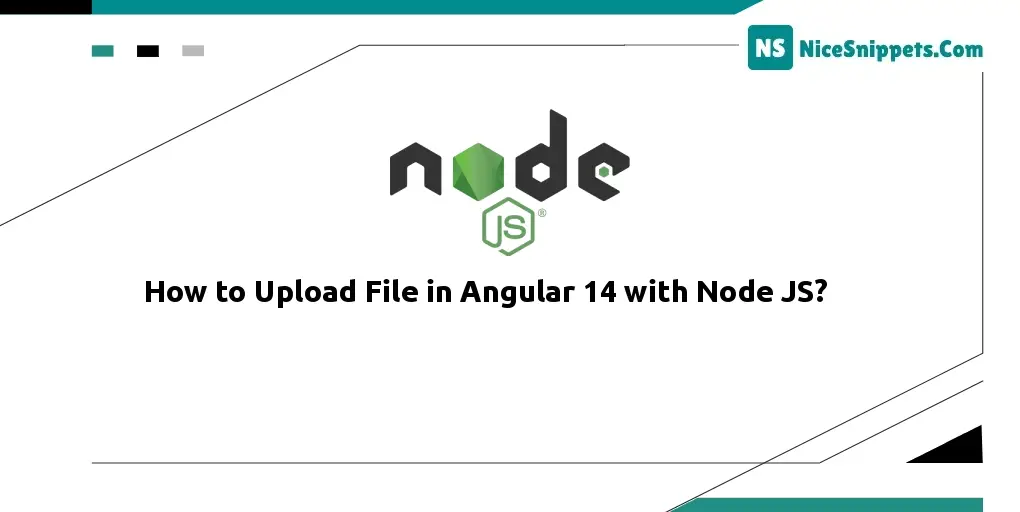25-Apr-2023
.
Admin

Hello Friends,
If you need to see an example of how to upload a file/image in the angular app with node express js. we will help you to give an example of an angular 14 node js file upload. if you have a question about how to upload files in angular with node js then I will give a simple example with a solution. let’s discuss upload files in angular. Let's see the bellow example image and file upload using node js in angular.
In this tutorial, we will learn how to upload a file or image in an Angular 14 app using Node Express.js. We'll demonstrate how to use form data to accomplish this task.
Create Angular Frontend App
Step 1: Create New Angular App
First of all, open your terminal and execute the following command on it to install angular app:
ng new my-new-app
Step 2: Install ng-file-upload Directive & toastr Notification
Open your terminal and execute the following command to install ng-file-upload Directive & toastr Notification in angular 12 app:
npm install @angular/animations --save
npm install ng2-file-upload
Then, add the ngx-toastr CSS in angular.json file:
"styles": [
"src/styles.css",
"node_modules/ngx-toastr/toastr.css"
]
Step 3: Import Installed Modules on app.module.ts
Then, Open app.module.ts file and import HttpClientModule, FormsModule, FileSelectDirective and ToastrModule to app.module.ts file like following:
import { FileSelectDirective } from 'ng2-file-upload';
import { FormsModule } from '@angular/forms';
import { ToastrModule } from 'ngx-toastr';
@NgModule({
declarations: [
FileSelectDirective
],
imports: [
FormsModule
BrowserModule,
BrowserAnimationsModule,
ToastrModule.forRoot()
]
})
export class AppModule { }
Step 4: Create File Upload Form
In this step, create html markup for file upload form with input file element and image tag. So, visit src/app/app.component.html and update the following code into it:
<div class="wrapper">
<h2>Angular Image Upload</h2>
<div class="file-upload">
<input type="file" name="image" ng2FileSelect [uploader]="uploader" accept="image/x-png,image/gif,image/jpeg" />
<button type="button" (click)="uploader.uploadAll()" [disabled]="!uploader.getNotUploadedItems().length">Upload</button>
</div>
</div>
Step 5: Import Components app.component.ts
In this step, visit the src/app directory and open app.component.ts. Then add the following code into it:
import { Component, OnInit } from '@angular/core';
import { FileUploader } from 'ng2-file-upload/ng2-file-upload';
import { ToastrService } from 'ngx-toastr';
const URL = 'http://localhost:3000/upload';
@Component({
selector: 'app-root',
templateUrl: './app.component.html',
styleUrls: ['./app.component.css']
})
export class AppComponent implements OnInit {
public uploader: FileUploader = new FileUploader({
url: URL,
itemAlias: 'image'
});
constructor(private toastr: ToastrService) { }
ngOnInit() {
this.uploader.onAfterAddingFile = (file) => {
file.withCredentials = false;
};
this.uploader.onCompleteItem = (item: any, status: any) => {
console.log('Uploaded File Details:', item);
this.toastr.success('File successfully uploaded!');
};
}
}
Then execute the following command on terminal to start the app to check out the File upload in the browser:
ng serve --open
Create Node Express JS Backend
Step 1: Create Node JS App
Open your terminal and execute the following command to create node js app:
mkdir my-app
cd my-app
npm init -y
Step 2: Install Express body parser and cors Dependencies
Execute the following commands to install imperative npm packages which will help us to create REST APIs for your angular file upload app:
npm install express express-fileupload body-parser cors
npm install nodemon --save-dev
Step 3: Create Server.js File
In this step, add the following code into it:
const express = require("express");
const fileupload = require("express-fileupload");
const cors = require("cors");
const bodyParser = require('body-parser');
const app = express();
app.use(cors());
app.use(fileupload());
app.use(express.static("files"));
app.use(bodyParser.json());
app.use(bodyParser.urlencoded({ extended: true }));
app.post("/upload", (req, res) => {
const newpath = __dirname + "/files/";
const file = req.files.file;
const filename = file.name;
file.mv(`${newpath}${filename}`, (err) => {
if (err) {
res.status(500).send({ message: "File upload failed", code: 200 });
}
res.status(200).send({ message: "File Uploaded", code: 200 });
});
});
app.listen(3000, () => {
console.log("Server running successfully on 3000");
});
Step 4: Start Node JS App
Start the server with the following command and then you can test the form:
npm start
OR
nodemon server.js
#Node.js Express